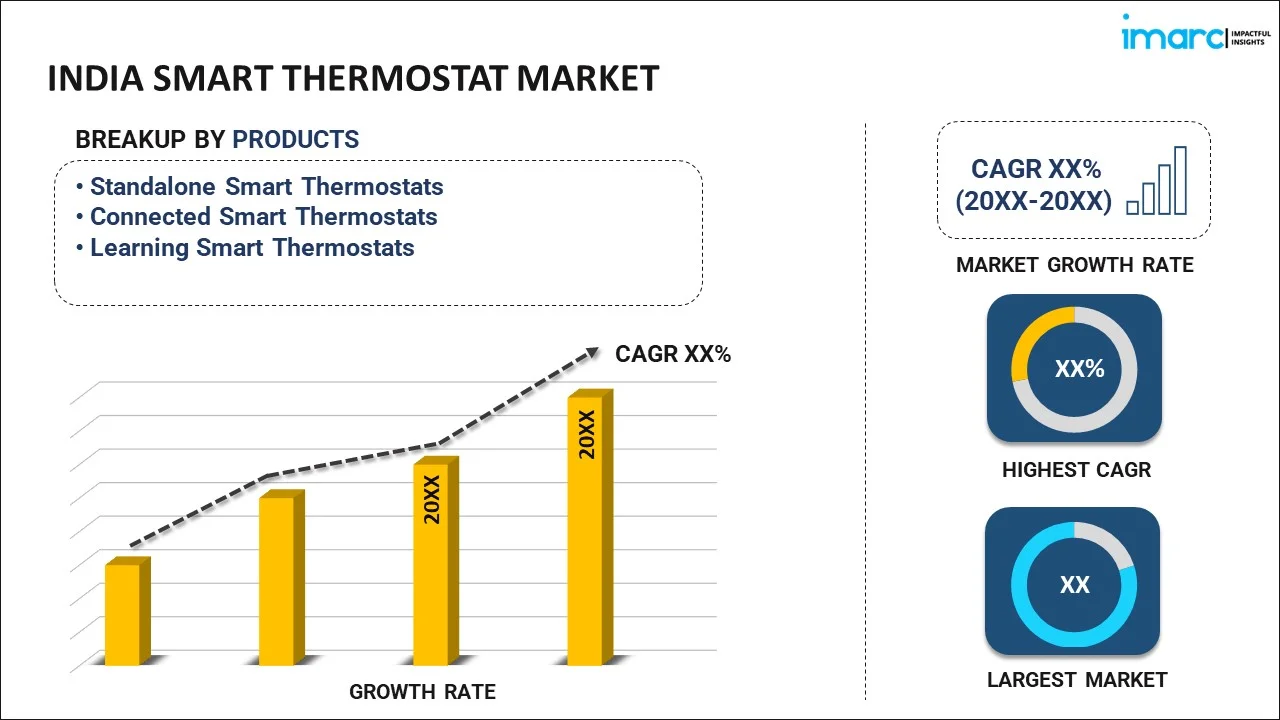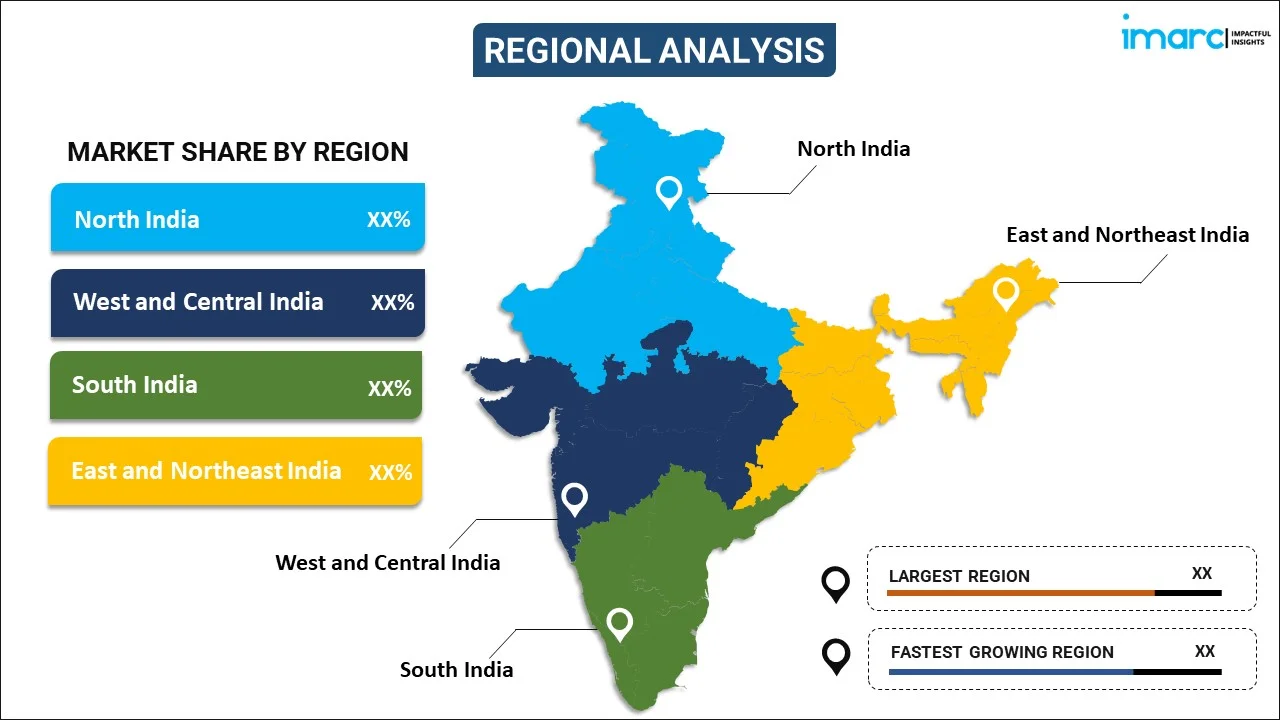
India Smart Thermostat Market Report by Product (Standalone Smart Thermostats, Connected Smart Thermostats, Learning Smart Thermostats), Component (Display, Temperature Sensors, Humidity Sensors, Motion Sensors, and Others), Technology (Wired, Wireless), Application (Residential, Commercial, Industrial), and Region 2025-2033
Market Overview:
India smart thermostat market size reached USD 130.2 Million in 2024. Looking forward, IMARC Group expects the market to reach USD 287.9 Million by 2033, exhibiting a growth rate (CAGR) of 9.22% during 2025-2033. The inflating need for creating a more energy-efficient and comfortable environment, along with the growing focus of key players on the integration of advanced technologies into daily life, is primarily driving the market growth.
|
Report Attribute
|
Key Statistics
|
|---|---|
|
Base Year
|
2024 |
|
Forecast Years
|
2025-2033 |
|
Historical Years
|
2019-2024
|
| Market Size in 2024 | USD 130.2 Million |
| Market Forecast in 2033 | USD 287.9 Million |
| Market Growth Rate (2025-2033) | 9.22% |
A smart thermostat is an innovative electronic device designed for the regulation and supervision of heating and cooling systems. Its components include temperature sensors, a display interface, occupancy sensors, a connectivity module, a microprocessor, and a memory chip. This advanced thermostat finds extensive applications in various settings, including households, commercial buildings, rental apartments, educational institutions, hotels, resorts, and government offices. Renowned for its efficiency, the smart thermostat allows users to remotely access and control it through smartphones and web interfaces. Beyond its convenience, it contributes to energy conservation, resulting in reduced utility bills, enhanced comfort, and the creation of a welcoming environment.
India Smart Thermostat Market Trends:
The smart thermostat market in India is experiencing a notable surge as the country embraces advanced technologies to enhance energy efficiency and create more comfortable living and working environments. In India, the adoption of smart thermostats extends across diverse settings, including households, commercial buildings, rental apartments, educational institutions, hotels, resorts, and government offices. Additionally, the efficiency of smart thermostats lies in their ability to provide remote access and control, allowing users to manage heating and cooling systems through smartphones and web interfaces. Moreover, this convenience aligns with the increasing demand for smart solutions that offer flexibility and ease of use. Furthermore, one of the primary advantages of smart thermostats in the Indian market is their contribution to energy conservation. Apart from this, by enabling users to monitor and regulate temperature settings remotely, these devices play a crucial role in optimizing energy usage, resulting in reduced utility bills. As the awareness of energy efficiency grows and the Internet of Things (IoT) becomes more prevalent in India, the smart thermostat market is poised for continued growth. In line with this, the convergence of technology and sustainability positions smart thermostats as key players in shaping the future of climate control solutions in the Indian context, which is anticipated to fuel the market growth in the coming years.
India Smart Thermostat Market Segmentation:
IMARC Group provides an analysis of the key trends in each segment of the market, along with forecasts at the country level for 2025-2033. Our report has categorized the market based on product, component, technology, and application.
Product Insights:

- Standalone Smart Thermostats
- Connected Smart Thermostats
- Learning Smart Thermostats
The report has provided a detailed breakup and analysis of the market based on the product. This includes standalone smart thermostats, connected smart thermostats, and learning smart thermostats.
Component Insights:
- Display
- Temperature Sensors
- Humidity Sensors
- Motion Sensors
- Others
A detailed breakup and analysis of the market based on the component have also been provided in the report. This includes display, temperature sensors, humidity sensors, motion sensors, and others.
Technology Insights:
- Wired
- Wireless
- WiFi
- Zig Bee
- Others
The report has provided a detailed breakup and analysis of the market based on the technology. This includes wired and wireless (wifi, zig bee, and others).
Application Insights:
- Residential
- Commercial
- Industrial
A detailed breakup and analysis of the market based on the application have also been provided in the report. This includes residential, commercial, and industrial.
Regional Insights:

- North India
- West and Central India
- South India
- East and Northeast India
The report has also provided a comprehensive analysis of all the major regional markets, which include North India, West and Central India, South India, and East and Northeast India.
Competitive Landscape:
The market research report has also provided a comprehensive analysis of the competitive landscape in the market. Competitive analysis such as market structure, key player positioning, top winning strategies, competitive dashboard, and company evaluation quadrant has been covered in the report. Also, detailed profiles of all major companies have been provided.
India Smart Thermostat Market Report Coverage:
| Report Features | Details |
|---|---|
| Base Year of the Analysis | 2024 |
| Historical Period | 2019-2024 |
| Forecast Period | 2025-2033 |
| Units | Million USD |
| Scope of the Report | Exploration of Historical Trends and Market Outlook, Industry Catalysts and Challenges, Segment-Wise Historical and Future Market Assessment:
|
| Products Covered | Standalone Smart Thermostats, Connected Smart Thermostats, Learning Smart Thermostats |
| Components Covered | Display, Temperature Sensors, Humidity Sensors, Motion Sensors, Others |
| Technologies Covered |
|
| Applications Covered | Residential, Commercial, Industrial |
| Regions Covered | North India, West and Central India, South India, East and Northeast India |
| Customization Scope | 10% Free Customization |
| Post-Sale Analyst Support | 10-12 Weeks |
| Delivery Format | PDF and Excel through Email (We can also provide the editable version of the report in PPT/Word format on special request) |
Key Questions Answered in This Report:
- How has the India smart thermostat market performed so far and how will it perform in the coming years?
- What has been the impact of COVID-19 on the India smart thermostat market?
- What is the breakup of the India smart thermostat market on the basis of product?
- What is the breakup of the India smart thermostat market on the basis of component?
- What is the breakup of the India smart thermostat market on the basis of technology?
- What is the breakup of the India smart thermostat market on the basis of application?
- What are the various stages in the value chain of the India smart thermostat market?
- What are the key driving factors and challenges in the India smart thermostat?
- What is the structure of the India smart thermostat market and who are the key players?
- What is the degree of competition in the India smart thermostat market?
Key Benefits for Stakeholders:
- IMARC’s industry report offers a comprehensive quantitative analysis of various market segments, historical and current market trends, market forecasts, and dynamics of the India smart thermostat market from 2019-2033.
- The research report provides the latest information on the market drivers, challenges, and opportunities in the India smart thermostat market.
- Porter's five forces analysis assist stakeholders in assessing the impact of new entrants, competitive rivalry, supplier power, buyer power, and the threat of substitution. It helps stakeholders to analyze the level of competition within the India smart thermostat industry and its attractiveness.
- Competitive landscape allows stakeholders to understand their competitive environment and provides an insight into the current positions of key players in the market.
Need more help?
- Speak to our experienced analysts for insights on the current market scenarios.
- Include additional segments and countries to customize the report as per your requirement.
- Gain an unparalleled competitive advantage in your domain by understanding how to utilize the report and positively impacting your operations and revenue.
- For further assistance, please connect with our analysts.
 Inquire Before Buying
Inquire Before Buying
 Speak to an Analyst
Speak to an Analyst
 Request Brochure
Request Brochure
 Request Customization
Request Customization




.webp)




.webp)












